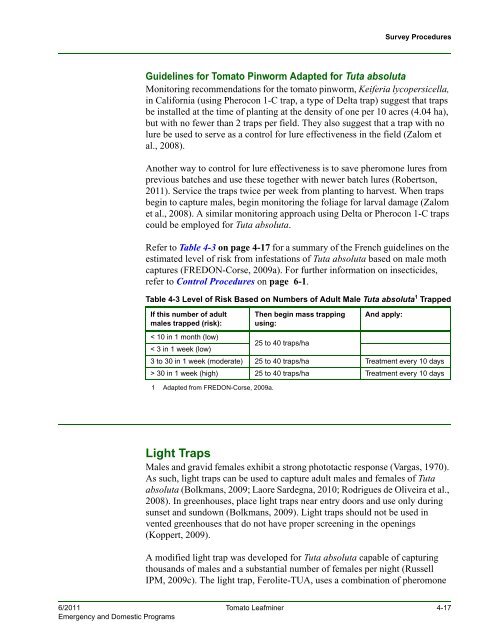1 - Phytosanitary Resources
1 - Phytosanitary Resources
1 - Phytosanitary Resources
Create successful ePaper yourself
Turn your PDF publications into a flip-book with our unique Google optimized e-Paper software.
Survey Procedures<br />
Guidelines for Tomato Pinworm Adapted for Tuta absoluta<br />
Monitoring recommendations for the tomato pinworm, Keiferia lycopersicella,<br />
in California (using Pherocon 1-C trap, a type of Delta trap) suggest that traps<br />
be installed at the time of planting at the density of one per 10 acres (4.04 ha),<br />
but with no fewer than 2 traps per field. They also suggest that a trap with no<br />
lure be used to serve as a control for lure effectiveness in the field (Zalom et<br />
al., 2008).<br />
Another way to control for lure effectiveness is to save pheromone lures from<br />
previous batches and use these together with newer batch lures (Robertson,<br />
2011). Service the traps twice per week from planting to harvest. When traps<br />
begin to capture males, begin monitoring the foliage for larval damage (Zalom<br />
et al., 2008). A similar monitoring approach using Delta or Pherocon 1-C traps<br />
could be employed for Tuta absoluta.<br />
Refer to Table 4-3 on page 4-17 for a summary of the French guidelines on the<br />
estimated level of risk from infestations of Tuta absoluta based on male moth<br />
captures (FREDON-Corse, 2009a). For further information on insecticides,<br />
refer to Control Procedures on page 6-1.<br />
Table 4-3 Level of Risk Based on Numbers of Adult Male Tuta absoluta 1 Trapped<br />
If this number of adult<br />
males trapped (risk):<br />
1 Adapted from FREDON-Corse, 2009a.<br />
Then begin mass trapping<br />
using:<br />
And apply:<br />
< 10 in 1 month (low)<br />
< 3 in 1 week (low)<br />
25 to 40 traps/ha<br />
3 to 30 in 1 week (moderate) 25 to 40 traps/ha Treatment every 10 days<br />
> 30 in 1 week (high) 25 to 40 traps/ha Treatment every 10 days<br />
Light Traps<br />
Males and gravid females exhibit a strong phototactic response (Vargas, 1970).<br />
As such, light traps can be used to capture adult males and females of Tuta<br />
absoluta (Bolkmans, 2009; Laore Sardegna, 2010; Rodrigues de Oliveira et al.,<br />
2008). In greenhouses, place light traps near entry doors and use only during<br />
sunset and sundown (Bolkmans, 2009). Light traps should not be used in<br />
vented greenhouses that do not have proper screening in the openings<br />
(Koppert, 2009).<br />
A modified light trap was developed for Tuta absoluta capable of capturing<br />
thousands of males and a substantial number of females per night (Russell<br />
IPM, 2009c). The light trap, Ferolite-TUA, uses a combination of pheromone<br />
6/2011 Tomato Leafminer 4-17<br />
Emergency and Domestic Programs













